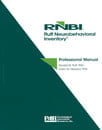
Ruff Neurobehavioral Inventory rnbi
For: Assess cognitive, emotional, physical, and psychosocial functioning, and general quality of life in ages 18 years and older
Reading Level: Adult - Elder Adult
Format: Paper-and-Pencil
Length: 30-45 minutes to administer; 15-20 minutes to score
Scoring: Hand Scored
Paper Forms & Handscoring Materials
Test forms, response booklets and scoring reference manuals.
RNBI Answer Booklets (25)
RNBI Profile Booklets (25)
RNBI Reusable Item Booklets (25)
Sample Reports
Authors
Ronald M. Ruff, PhD, Kristin M. Hibbard, PhD
Description
The RNBI is a 243-item self-report questionnaire that assesses an individual’s perception of the important dimensions of their daily life activities following a catastrophic event, such as a major illness or injury.
The RNBI may provide diagnostic insights and assess treatment outcome. During the recovery phase, the RNBI can track the rate of improvement based on the patient’s self-perceptions of daily problems. Understanding the level of the patient’s self-awareness is essential for diagnosis, as well as for treatment programs that depend on behavioural interventions. The responses are ecologically valid, because most questions rely on the performance of daily functional activities.
The RNBI uses two different types of questions to assess both pre-morbid and post-morbid intrapersonal and interpersonal functioning. The intrapersonal component evaluates the neurobehavioural functions that rely on internal resources. The interpersonal component reflects the individual’s vocational, financial, recreational, social and spiritual areas of functioning. Comparing the pre-morbid and post-morbid responses allows the clinician to identify functional areas that may have been directly affected as a result of the catastrophic event (illness or injury).
The RNBI consists of 17 Pre-morbid Basic scales and 18 Post-morbid Basic scales. Scale scores are combined to create four Pre-morbid and four Post-morbid Composite scale scores that provide global information about the individual’s perceived cognitive, emotional, and physical functioning, as well as their overall quality of life. The RNBI also contains four Validity scales: two that assess abnormal response styles (i.e. Inconsistency and Infrequency), and two that assess impression management (i.e. Negative and Positive). The 17 RNBI Critical Items provide additional interpretive information according to various clinical areas of interest.
The RNBI offers a number of advantages over a general history form.
Gathers data according to theoretical constructs (responses are scaled psychometrically).
Allows judgments based on normative data for either the general population or a clinical population.
Captures premorbid functions in a comprehensive manner, facilitating a direct comparison between pre-morbid and post-morbid functioning.
Allows the clinician to analyse comparable scales and explore potential interactions among reported symptoms.
Provides four Validity scales (Infrequency/Inconsistency and Negative/Positive).
Presents information about perceived functioning that may be integrated with performance-based assessments of functioning.
Administration
Completion of the self-report questionnaire requires at least a fourth-grade reading level. Although the performance of individuals whose native language is not English has not been specifically evaluated, the RNBI items were carefully screened during test construction to avoid confusing or idiomatic phrases. Administration and scoring are straightforward. Interpretation requires an understanding of theories of psychopathology and neuropathology, as well as brain-behaviour relationships.
The reusable RNBI Item Booklet and the carbonless RNBI Answer Booklet provide all instructions for completing the 243-item self-report questionnaire. The Answer Booklet provides spaces for entering basic demographic and historical information, as well as item responses. The 124 Post-morbid items appear first, followed by the 119 Pre-morbid items. For the Post-morbid items, respondents are asked to select the response that best corresponds to the way they have felt during the last few weeks. For the Premorbid items, respondents select the response that best corresponds to the way they felt at some earlier time(s) in their life (i.e. prior to the catastrophic event or illness). The clinician detaches the top Answer Sheet, revealing the Scoring Sheet which provides the scores corresponding to each response option. These scores are used to obtain the RNBI Basic and Composite scale scores.
The RNBI Profile Booklet contains profile grids for the Composite and Basic scales and for the Validity scales. Raw scores are transferred from the Scoring Sheet to the appropriate spaces in the Profile Booklet, transformed into T scores, and then plotted on the grids. The back page of the Profile Booklet presents the Critical Items and provides space for recording Critical Item responses.
Standardisation
The development and norming of the RNBI involved multiple samples obtained across a variety of settings. Two primary samples (standardisation sample and clinical sample) were used to establish the normative and psychometric properties of the instrument. The standardisation sample included 1,024 community-dwelling adults. The RNBI Professional Manual provides T scores based on this total sample, as well as for two age groups within the sample: 18-45 years and 46-75 years. The clinical sample included 195 patients with varying diagnoses (e.g. chronic pain disorder, CVA, TBI, and spinal cord injury).
Reliability and Validity
In general, the RNBI scale scores exhibit adequate levels of reliability (test-retest and internal consistency) across both the standardisation and clinical samples.
RNBI Scoring Program Included With Introductory Kit
The RNBI-SP aids in the scoring and profiling of the RNBI. After hand entry of an individual’s item responses, the software creates a comprehensive Score Report with Score Summary Tables for both the Validity and Content scales. The Validity section contains brief interpretive text to help you understand an individual’s results. The Software also features a T-score profile, a Critical Items Table, and Item Response Tables that are divided by scale. The Score Summary Tables consist of raw scores, T scores, and Qualitative Interpretive Ranges for both the pre-morbid and post-morbid components of each scale, along with the T-score difference.
System Requirements
Windows XP, Vista, 7, 8, 10.
Mac users: install Windows in VirtualBox or BootCamp.
Other virtual machine solutions (e.g., Parallels, VMWare) are not supported.
Prerequisites
NTFS file system; Internet connection or telephone for activation; CD-ROM drive for installation
NB: Prices are in Australian dollars inclusive of GST. NZ customers need to log in to view ex-GST prices.




